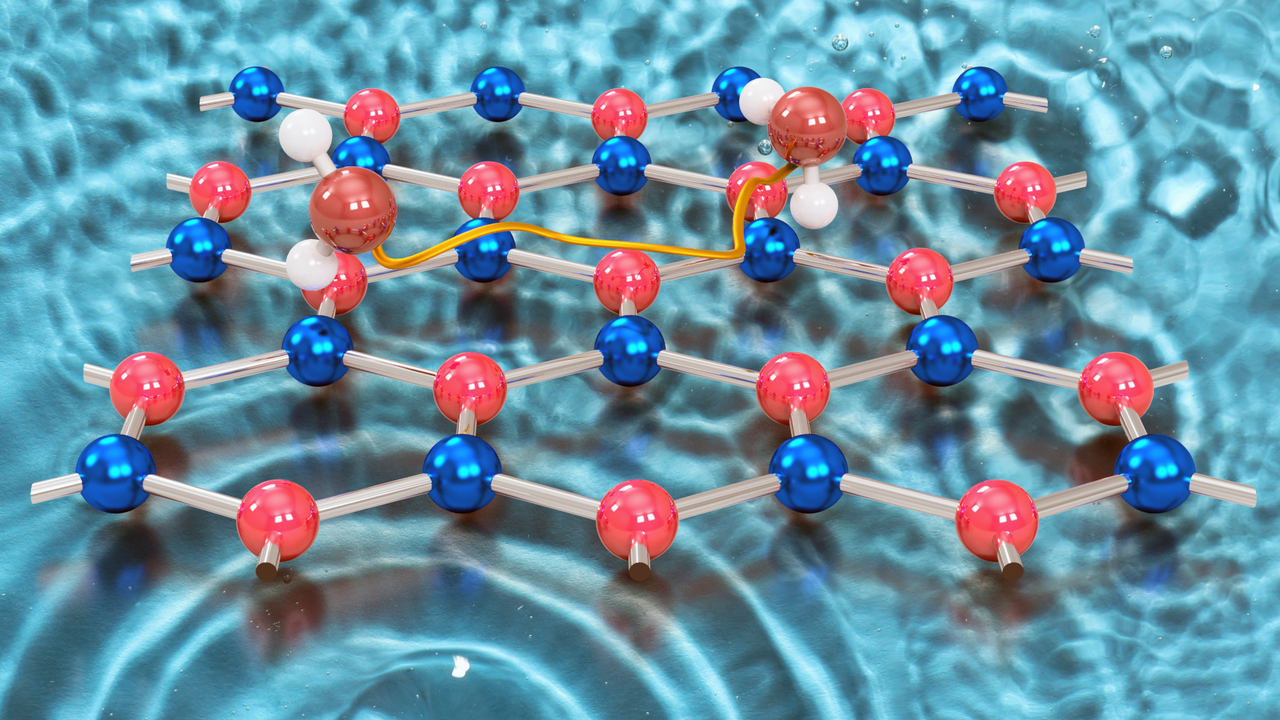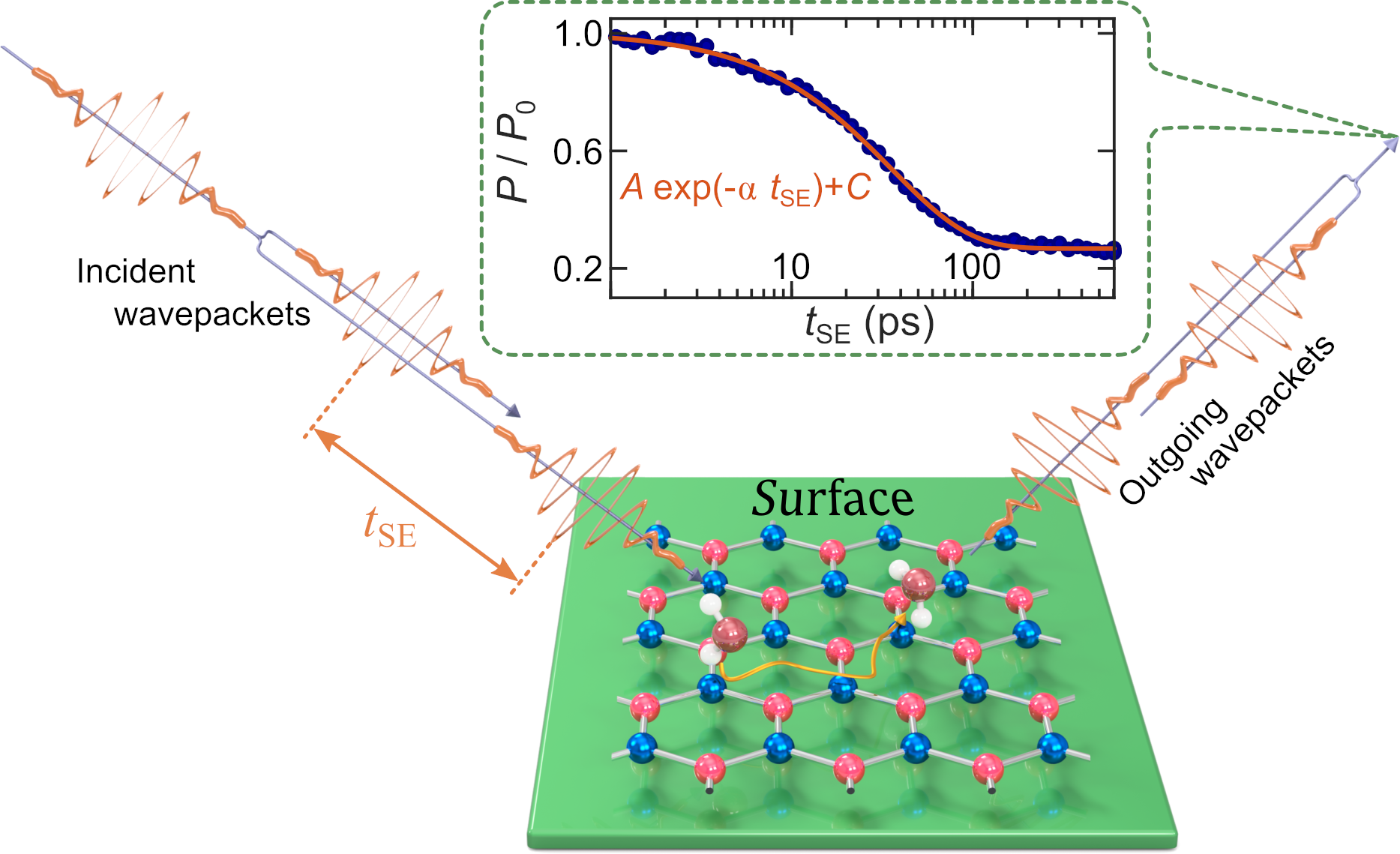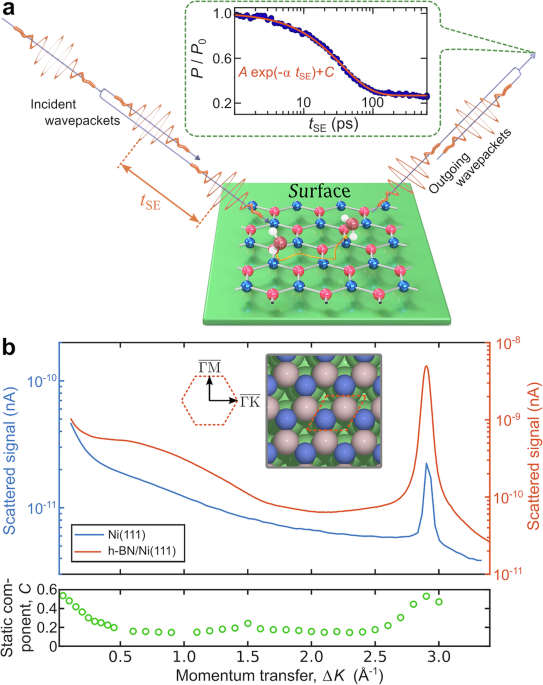Water dances on hexagonal boron nitride

The Strange Journey of a Single Water Molecule
The motion of a single water molecule on a solid surface might appear deceptively simple, yet tracking such movement at atomic resolution and on picosecond timescales remains exceptionally challenging. Despite this, resolving these dynamics is vital, as they underpin fundamental processes in nanoscale transport, wetting, and interfacial chemistry.[1]
In our study, we investigate how water interacts with two structurally similar, but electronically distinct, two-dimensional (2D) materials: graphene and hexagonal boron nitride (h-BN).[2,3] Both are atomically thin, mechanically robust, and technologically promising, yet water behaves very differently on each.
To probe this behaviour at the single-molecule level, we combined helium spin-echo (HeSE) spectroscopy — a technique offering measurements of motion on picosecond timescales without disruption of the motion itself — with ab initio molecular dynamics (AIMD) simulations to obtain a comprehensive picture of water dynamics on these surfaces.[4]

Measuring picosecond dynamics on h-BN
Our experimental setup employs HeSE as illustrated in Figure 1, which measures the decay of surface correlations as helium atoms scatter off moving adsorbates.[5] In this case, we tracked the motion of individual water molecules on h-BN grown on Ni(111).
From these measurements, we found that the activation energy for water motion on h-BN is remarkably low — just 24 meV, which is over 2.5 times smaller than the value previously observed for water on graphene. This implies that, while water binds comparably to both surfaces, the energy barriers for movement on h-BN/Ni are significantly reduced.[4]
A different kind of diffusion: spinning, flipping, gliding
The experimental data from HeSE also points to a motion that cannot be described by simple hopping. Instead, it suggests a rich interplay of translational and internal molecular dynamics. This is illustrated by our AIMD simulations, which show that water on h-BN/Ni(111) does not simply jump from one adsorption site to another. Rather, it glides smoothly, while rotating and flipping — a motion akin to walking, with the molecule’s O–H bonds precessing around its centre of mass.
Video Description: The side view in the top panel reveals the vertical fluctuations and adsorption geometry of the water molecule relative to the surface. The bottom panel shows a top view, highlighting the lateral diffusion pathway with characteristic rotational and precessional dynamics of the water molecule as it traverses the h-BN/Ni(111) surface — a “walking” motion enabled by the smoother energy landscape.[4]
In contrast, as illustrated in Figure 2, water on graphene/Ni(111) follows a more discrete, stepwise diffusion path with consecutive jumps, maintaining a relatively fixed orientation — a fundamental difference in molecular dynamics driven by the nature of the underlying surface.[6]

Friction on 2D materials: The unexpected role of the substrate
To quantify how easily water moves, we calculated the atomic-scale friction coefficient λGK using the Green-Kubo formalism, based on forces obtained from AIMD simulations. Interestingly, for freestanding materials, friction on h-BN is higher than on graphene — consistent with previous results by Tocci et al.[7] However, when supported on a Ni(111) substrate, this relationship is reversed.

Water experiences nearly eight times lower friction on h-BN/Ni(111) compared to graphene/Ni(111). This reversal is rooted in how the substrate alters the energy landscape and vibrational coupling: on graphene/Ni, stronger coupling to stretching modes increases molecular resistance, whereas h-BN/Ni offers a smoother potential energy surface and less restrictive vibrational dynamics.[4]
Applications and outlook
This study highlights how even structurally similar surfaces can exhibit dramatically different molecular-scale water dynamics, and how those dynamics are strongly influenced by the supporting substrate. For designers of microfluidic devices, anti-icing coatings, or selective membranes, this suggests a powerful design strategy: Tuning water mobility not just through the 2D layer, but also through the underlying support.
The findings also challenge the traditional view of friction as a macroscopic average. At the single-molecule level, internal motion — rotation, bending, stretching — becomes critical. Future studies could explore this through a “state-resolved” view of friction and test the impact of other substrates or materials, where single-molecule perspectives are still largely unexplored.
[1] Sacchi, M. & Tamtögl, A. Water adsorption and dynamics on graphene and other 2D materials: computational and experimental advances. Adv. Phys.: X 8, 2134051 (2023)
[2] Ferrari, A. C. et al. Science and technology roadmap for graphene, related two-dimensional crystals, and hybrid systems. Nanoscale 7, 4598 (2015).
[3] Cassabois, G., Valvin, P. & Gil, B. Hexagonal boron nitride is an indirect bandgap semiconductor. Nat. Photonics 10, 262 (2016).
[4] Seiler, P., Payne, A.J.R., Xavier Jr, N.F. et al. Understanding water behaviour on 2D material interfaces through single-molecule motion on h-BN and graphene. Nat Commun 16, 10465 (2025).
[5] Tamtögl A., Sacchi M., Nanoscale motion of organic π-conjugated molecules: exploring van der Waals forces, friction, and quantum effects. Nanoscale Horiz. 10, 3158 (2025).
[6] A. Tamtögl, E. Bahn, M. Sacchi, J. Zhu, D. J. Ward, A. P. Jardine, S. J. Jenkins, P. Fouquet, J. Ellis and W. Allison, Nat. commun., 12, 3120 (2021).
[7] Tocci, G., Joly, L. & Michaelides, A. Friction of water on graphene and hexagonal boron nitride from Ab initio methods: very different slippage despite very similar interface structures. Nano Lett. 14, 6872 (2014).
Follow the Topic
-
Nature Communications

An open access, multidisciplinary journal dedicated to publishing high-quality research in all areas of the biological, health, physical, chemical and Earth sciences.
Related Collections
With Collections, you can get published faster and increase your visibility.
Women's Health
Publishing Model: Hybrid
Deadline: Ongoing
Advances in neurodegenerative diseases
Publishing Model: Hybrid
Deadline: Mar 24, 2026





Please sign in or register for FREE
If you are a registered user on Research Communities by Springer Nature, please sign in